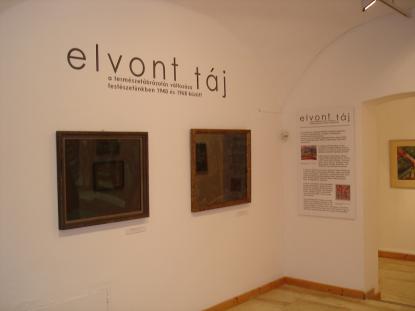2024. May 4. Saturday
King St. Stephen Museum - Town Gallery - Deák Collection - Székesfehérvár
|
|
Address: 8000, Székesfehérvár Oskola utca 10.
Phone number: (22) 329-431
E-mail: titkarsag@szikm.hu
Opening hours: Temporarily closed.
|
The exhibition has closed for visitors.
2011.10.14. - 2012.01.15.
Museum tickets, service costs:
|
Group ticket
(from over 10 people)
|
500 HUF
|
|
|
Ticket for adults
|
700 HUF
|
|
|
Ticket for students
|
350 HUF
|
|
|
Ticket for pensioners
|
350 HUF
|
Non-figurative arts have two sources: one was geometric art, the other was spectacle. Our present exhibition is more about landscape representations related to the latter way of expression from the period from 1940 to 1968.

The beginning of abstract arts is interwoven with the landscapes by János Máttis Teutsch from the second half of the 19l0s. Between WWI and WWII, József Egry, later on Menyhért Tóth, young artists at the KÚT and the UME - Jenő Barcsay, Gyula Hincz, Jenő Gadányi, Géza Bene, and Erzsébet Vaszkó - did works of this sort. After WWII, artists at the European Art School followed on that path, e.g. Ferenc Martyn, Tihamér Gyarmathy or the less known Anna Stark. Following the socialist-realist intentions in the 50s the most acknowledged artists involved in abstract art were Béla Veszelszky, László Bartha, and Tibor Csernus Ignác Kokas.
Artists working more in the Paris School style were inspired by e.g. Manessier's abstraction. Such artists were often members of the Zugló Circle of Artists, e.g. Sándor Molnár, Endre Hortobágyi, László Molnár in the 60s. With these works of arts, we can say that spectacle-based abstraction was over since at the end of the decade artists in the groups 'Iparterv' and 'Szürenon' were inspired by abstract expressionism and pop art.
The curator of the exhibition is the art historian Lajos Lóska

The beginning of abstract arts is interwoven with the landscapes by János Máttis Teutsch from the second half of the 19l0s. Between WWI and WWII, József Egry, later on Menyhért Tóth, young artists at the KÚT and the UME - Jenő Barcsay, Gyula Hincz, Jenő Gadányi, Géza Bene, and Erzsébet Vaszkó - did works of this sort. After WWII, artists at the European Art School followed on that path, e.g. Ferenc Martyn, Tihamér Gyarmathy or the less known Anna Stark. Following the socialist-realist intentions in the 50s the most acknowledged artists involved in abstract art were Béla Veszelszky, László Bartha, and Tibor Csernus Ignác Kokas.
Artists working more in the Paris School style were inspired by e.g. Manessier's abstraction. Such artists were often members of the Zugló Circle of Artists, e.g. Sándor Molnár, Endre Hortobágyi, László Molnár in the 60s. With these works of arts, we can say that spectacle-based abstraction was over since at the end of the decade artists in the groups 'Iparterv' and 'Szürenon' were inspired by abstract expressionism and pop art.
The curator of the exhibition is the art historian Lajos Lóska
